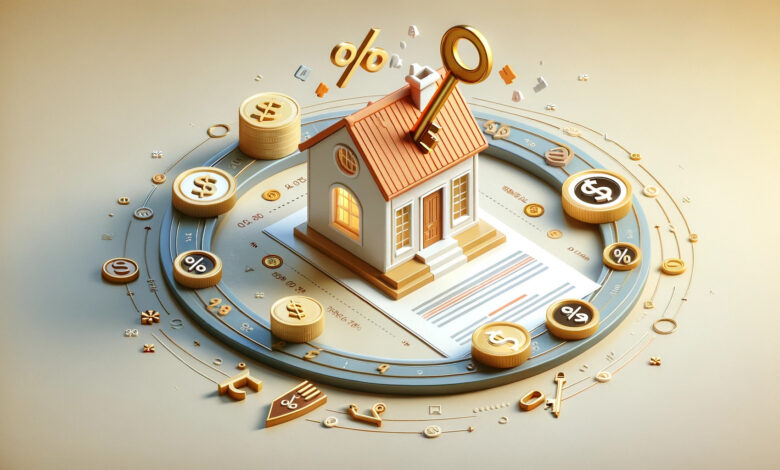What is Adjustable Rate Mortgage: A Comprehensive Guide

Are you in the market for a new mortgage? If so, you’ve probably come across the term “adjustable rate mortgage” or ARM. But what exactly does it mean? In this comprehensive guide, we’ll delve into the world of adjustable rate mortgages and shed light on how they work, their benefits, and potential drawbacks. By the end of this article, you’ll have a clear understanding of what an adjustable rate mortgage is and whether it’s the right choice for you.
Understanding Adjustable Rate Mortgage (ARM)
What is an Adjustable Rate Mortgage?
An adjustable rate mortgage, or ARM, is a type of mortgage loan where the interest rate can fluctuate over time. Unlike a fixed-rate mortgage, where the interest rate remains constant throughout the loan term, an ARM offers an initial fixed-rate period followed by periodic adjustments. This means that your monthly mortgage payments can increase or decrease based on market conditions.
How does an ARM differ from a fixed-rate mortgage?
One of the key differences between an ARM and a fixed-rate mortgage is the initial interest rate. With an ARM, the introductory rate is typically lower than that of a fixed-rate mortgage. This can make an ARM an attractive option for borrowers who plan to sell or refinance their homes before the initial fixed-rate period ends.
Understanding interest rate fluctuations in an ARM
In an adjustable rate mortgage, the interest rate is tied to an index, such as the U.S. Treasury Bill rate or the London Interbank Offered Rate (LIBOR). The lender adds a margin to the index rate to determine the fully indexed rate, which is the rate you will pay. When the index rate changes, your interest rate will adjust accordingly. It’s important to note that ARM loans often have rate caps to protect borrowers from extreme rate fluctuations.
How Does an Adjustable Rate Mortgage Work?
To better understand how an adjustable rate mortgage works, let’s delve into its structure and functioning.
The structure of an ARM
An ARM consists of two main periods: the initial fixed-rate period and the adjustment period. During the initial fixed-rate period, which typically lasts for a few years, your interest rate remains fixed and your monthly payments are consistent. Once this period ends, the interest rate adjusts periodically based on the terms of your loan.
The index and margin
The interest rate adjustments in an ARM are determined by the combination of an index and a margin. The index represents a benchmark interest rate, while the margin is a fixed percentage set by the lender. For example, if the index is 3% and the margin is 2%, your fully indexed rate would be 5%. It’s crucial to understand which index your ARM is linked to and how it behaves in different market conditions.
Pros and Cons of Adjustable Rate Mortgages
Before considering an adjustable rate mortgage, it’s essential to weigh the advantages and disadvantages.
Benefits of an ARM
One of the primary benefits of an ARM is the lower initial interest rate. This can result in lower monthly payments during the fixed-rate period, allowing borrowers to save money or afford a more expensive home. Additionally, if you plan to sell or refinance before the rate adjusts, an ARM can be a smart financial choice.
Drawbacks of an ARM
While the initial lower interest rate may be enticing, it’s important to remember that an ARM’s rates can increase significantly after the fixed-rate period. This means your monthly payments could rise substantially, potentially straining your budget. It’s crucial to consider your long-term financial goals, your ability to handle payment fluctuations, and the potential risk of rising interest rates.
Frequently Asked Questions (FAQ) about Adjustable Rate Mortgages
To provide further clarity, let’s address some common questions about adjustable rate mortgages.
Are ARMs suitable for everyone?
Adjustable rate mortgages are not a one-size-fits-all solution. They can be a good option for borrowers who plan to sell or refinance within the initial fixed-rate period or those who are confident in their ability to handle potential payment fluctuations. However, if you prefer stability and predictability, a fixed-rate mortgage might be a better choice.
What happens if interest rates rise?
If interest rates rise, your ARM’s interest rate will also increase during the adjustment period. This can result in higher monthly payments. However, ARM loans typically have rate caps that limit how much your interest rate can increase per adjustment period and over the life of the loan. Understanding these rate caps is vital to assess the potential impact of rising interest rates on your mortgage.
Can I refinance my ARM?
Yes, refinancing an ARM is a viable option if you decide that an adjustable rate mortgage no longer suits your needs. Refinancing allows you to convert your ARM into a fixed-rate mortgage, providing stability and potentially lower interest rates. However, it’s essential to consider the costs and potential savings associated with refinancing before making a decision.
Conclusion
In conclusion, an adjustable rate mortgage can be an attractive option for borrowers seeking lower initial interest rates and short-term homeownership plans. However, it’s crucial to carefully consider the potential risks and drawbacks associated with adjustable rate mortgages, such as the possibility of rising interest rates and payment fluctuations. By understanding how ARMs work and assessing your long-term financial goals, you can make an informed decision about whether an adjustable rate mortgage is the right choice for you. Remember, always consult with a mortgage professional to ensure you make the best decision for your unique circumstances.

